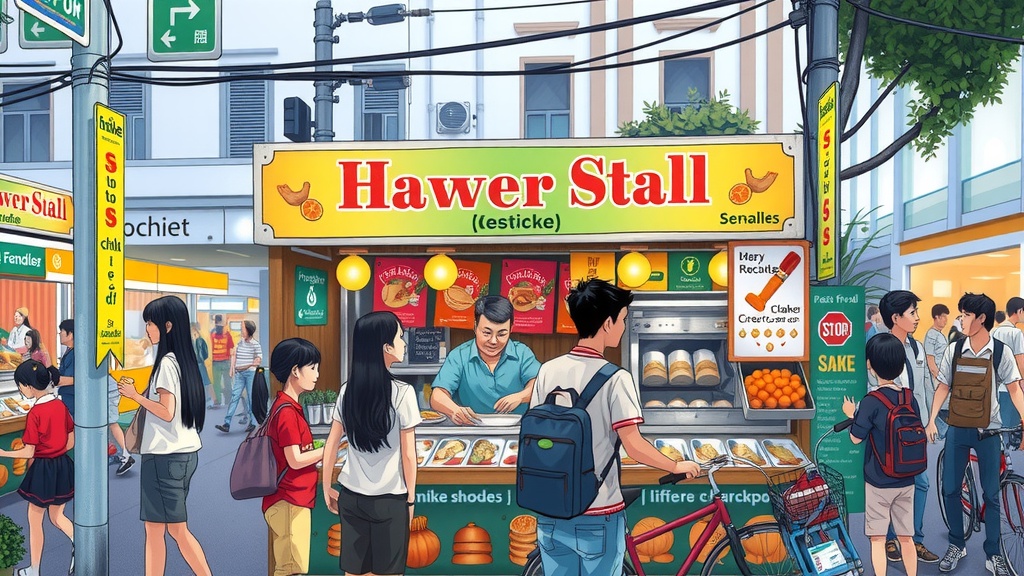Imagine the bustling streets of Dhaka, Chattogram, or any major city in Bangladesh. Amidst the honking rickshaws and chattering crowds, you'll find a vibrant character: the street hawker. They're not just selling goods; they're selling a piece of the city's soul. But what exactly is a street hawker? Let's explore this fascinating part of Bangladeshi culture, and how to write about them effectively in your exams.
A Street Hawker: A Paragraph for Students of All Classes
Whether you're in Class 6, preparing for your SSC, or tackling your HSC, understanding the role and life of a street hawker is important. This essay will guide you on how to write a compelling paragraph about them, with examples tailored for different word counts. We'll also explore the challenges they face, their economic impact, and the unique charm they bring to our streets.
What is a Street Hawker?
A street hawker, also known as a street vendor or peddler, is someone who sells goods or services in public places like streets, sidewalks, and marketplaces. They typically operate from temporary setups, such as carts, stalls, or even just a mat laid out on the ground. Street hawkers are a common sight in many countries, especially in developing nations like Bangladesh, where they provide affordable goods and services to a wide range of people.
Think of them as miniature, mobile shops bringing convenience to your doorstep. They might be selling jhalmuri (spicy puffed rice), colorful toys, clothes, or even offering services like shoe repair.
Why are Street Hawkers Important?
Street hawkers play a significant role in the economy, especially in a country like Bangladesh. They provide livelihoods for many people, often from low-income backgrounds. They also offer affordable goods and services to consumers, making essential items accessible to those who might not be able to afford them in traditional stores.
Furthermore, they contribute to the vibrant atmosphere of our cities, adding color and character to the streets. In many ways, they are an integral part of the social and economic fabric of Bangladesh.
Writing a Paragraph About a Street Hawker: Different Lengths for Different Classes
Here are examples of paragraphs about street hawkers, tailored for different word counts commonly required in school and college exams:
1. Paragraph on Street Hawker (150 Words)
A street hawker is a common sight in Bangladesh. They are vendors who sell goods on the streets or sidewalks. They usually have a small cart or a temporary stall. Street hawkers sell a variety of items, like food, clothes, toys, and household goods. They provide affordable products to people, especially those with low incomes.
Street hawkers play a vital role in the local economy. They offer employment opportunities and contribute to the informal sector. However, they often face challenges like harassment from authorities and competition from larger businesses. Despite these difficulties, street hawkers remain an essential part of the urban landscape, adding vibrancy and convenience to our daily lives. They are a symbol of resilience and entrepreneurship in Bangladesh.
2. Paragraph on Street Hawker (250 Words)
A street hawker is an integral part of the Bangladeshi urban landscape. These vendors are commonly seen selling goods from temporary setups on streets and sidewalks. They offer a wide range of products, from delicious street food like * ফুচকা (fuchka)* and Chotpoti to clothing, toys, and household items. Their affordability makes them particularly important for low-income communities.
Street hawkers contribute significantly to the informal economy. They create self-employment opportunities and provide a source of income for many families. However, their work is often challenging. They face issues such as limited access to capital, harassment from local authorities, and competition from established businesses. Moreover, they often lack social security and legal protection.
Despite these challenges, street hawkers persevere. They are known for their hard work, resilience, and entrepreneurial spirit. They bring vibrancy and convenience to the streets, making life easier for many. Their presence adds character to the urban environment, reflecting the dynamic and diverse nature of Bangladeshi society. Recognizing and supporting street hawkers is crucial for promoting inclusive economic growth.
3. Paragraph on Street Hawker (300 Words)
The bustling streets of Bangladesh are incomplete without the presence of street hawkers. These enterprising individuals set up temporary stalls or carts on sidewalks and roadsides, offering a diverse array of goods and services. From mouthwatering street food like jhalmuri and singara to clothing, accessories, toys, and household items, street hawkers cater to the needs of a wide range of customers, particularly those from lower-income backgrounds. Their affordability and convenience make them an indispensable part of urban life.
Street hawkers play a crucial role in the informal economy of Bangladesh. They provide self-employment opportunities for a significant portion of the population, contributing to poverty reduction and economic empowerment. By offering affordable goods and services, they also help to improve the living standards of many families. However, street hawkers often operate under challenging conditions. They face constant threats of eviction, harassment from local authorities, and competition from larger businesses. They also lack access to basic amenities and social security benefits.
Despite these obstacles, street hawkers demonstrate remarkable resilience and determination. They work long hours, often in harsh weather conditions, to earn a living and support their families. They are an embodiment of the entrepreneurial spirit and a testament to the human capacity to overcome adversity. Recognizing and supporting street hawkers is essential for promoting inclusive and sustainable economic development. This includes providing them with access to credit, training, and social protection, as well as creating a regulatory environment that is fair and supportive. By empowering street hawkers, we can unlock their potential to contribute even more to the economic and social progress of Bangladesh.
Key Vocabulary for Writing About Street Hawkers
To write a compelling paragraph about street hawkers, it's useful to know some relevant vocabulary:
- Vendor: A person who sells goods or services.
- Peddler: Similar to a vendor, often selling goods by going from place to place.
- Stall: A booth or stand where goods are displayed for sale.
- Cart: A wheeled vehicle used for transporting goods.
- Informal Economy: Economic activities that are not regulated or taxed by the government.
- Livelihood: The means of supporting oneself, especially financially.
- Entrepreneur: A person who organizes and operates a business, taking on greater than normal financial risks in order to do so.
- Resilience: The ability to recover quickly from difficulties; toughness.
- Harassment: Aggressive pressure or intimidation.
- Eviction: The action of expelling someone from a property.
- Affordable: Not too expensive; within one's financial means.
- Convenience: The state of being able to proceed with something without difficulty.
Street Hawker Paragraph Bangla Meaning
To further understand the concept, let's look at a translation of the key points into Bangla:
"একজন রাস্তার হকার হলেন সেই ব্যক্তি যিনি রাস্তা বা ফুটপাতে অস্থায়ী দোকানে জিনিসপত্র বিক্রি করেন। তারা খাবার, কাপড়, খেলনা এবং অন্যান্য জিনিস বিক্রি করে। তারা কম দামে জিনিস বিক্রি করে গরিবদের সাহায্য করে। তারা আমাদের অর্থনীতির জন্য খুবই গুরুত্বপূর্ণ, কিন্তু তাদের অনেক সমস্যা আছে।"
(Ekjon rastar hawker holen sei byakti jini rasta ba footpath-e asthayi dokane jinishpotro bikri koren. Tara khabar, kapor, khelna ebong onnano jinish bikri kore. Tara kom dame jinish bikri kore goribder shahajjo kore. Tara amader orthonitir jonno khuboi gurত্বপূর্ণ, kintu tader onek somossa ache.)
This translates to: "A street hawker is someone who sells goods in temporary shops on the street or sidewalk. They sell food, clothes, toys, and other things. They help the poor by selling things at low prices. They are very important for our economy, but they have many problems."
Challenges Faced by Street Hawkers
Street hawkers face numerous challenges in their daily lives. Understanding these challenges can add depth to your writing.
1. Legal and Regulatory Issues
Many street hawkers operate without proper licenses or permits, making them vulnerable to harassment and eviction by local authorities. The lack of clear regulations and policies often creates uncertainty and insecurity for these vendors.
2. Economic Challenges
Street hawkers often have limited access to capital, making it difficult for them to invest in their businesses and improve their livelihoods. They also face competition from larger businesses with greater resources and marketing capabilities.
3. Social Challenges
Street hawkers often face social stigma and discrimination due to their informal status and low incomes. They may also lack access to basic amenities such as clean water, sanitation, and healthcare.
4. Environmental Challenges
Street hawkers often work in harsh and unsanitary conditions, exposed to pollution, traffic, and extreme weather. This can have a negative impact on their health and well-being.
The Economic Impact of Street Hawkers
Despite the challenges they face, street hawkers make a significant contribution to the economy of Bangladesh.
1. Employment Generation
Street hawking provides self-employment opportunities for a large number of people, particularly those from low-income backgrounds. It serves as a safety net for those who are unable to find formal employment.
2. Affordable Goods and Services
Street hawkers offer affordable goods and services to consumers, making essential items accessible to those who might not be able to afford them in traditional stores. This helps to improve the living standards of low-income communities.
3. Contribution to the Informal Economy
Street hawkers are an important part of the informal economy, contributing to economic growth and poverty reduction. They generate income, pay taxes (in some cases), and create demand for goods and services.
4. Promotion of Local Products
Many street hawkers sell locally produced goods, helping to support local industries and preserve traditional crafts. This contributes to the cultural heritage and economic diversity of Bangladesh.
How to Make Your Paragraph More Engaging
Here are some tips to make your paragraph about a street hawker more interesting and engaging:
- Use vivid descriptions: Describe the sights, sounds, and smells of the street where the hawker operates.
- Tell a story: Share a brief anecdote about a street hawker you have encountered.
- Focus on the human element: Highlight the hawker's hard work, resilience, and entrepreneurial spirit.
- Use sensory details: Engage the reader's senses by describing the taste of the food, the texture of the fabric, or the sound of the hawker's voice.
- Incorporate dialogue: Include a short conversation between the hawker and a customer.
- Add a personal touch: Share your own thoughts and feelings about street hawkers.
Examples of Engaging Sentences
Here are some examples of sentences that you can use to make your paragraph more engaging:
- "The aroma of freshly fried pakoras filled the air as the street hawker expertly flipped them in his sizzling pan."
- "With a smile as bright as the colorful bangles he was selling, the hawker greeted each customer with warmth and enthusiasm."
- "Despite the scorching heat, the street hawker tirelessly peddled his cart through the crowded streets, his voice hoarse but his spirit undeterred."
- "I watched in admiration as the street hawker skillfully repaired a torn shoe, his hands moving with practiced precision."
- "The street hawker's stall was a treasure trove of affordable delights, from crispy jilapis to vibrant toys that sparkled in the sunlight."
FAQs About Street Hawkers
Let's address some frequently asked questions about street hawkers:
1. What are the main products sold by street hawkers in Bangladesh?
Street hawkers sell a wide variety of products, including:
- Food: Fuchka, Chotpoti, Jhalmuri, Singara, Samosa, Tea, Juice
- Clothing: Ready-made garments, Sarees, Lungi, T-shirts
- Accessories: Bangles, Earrings, Necklaces, Belts, Wallets
- Household Items: Plastic containers, Kitchen utensils, Cleaning supplies
- Toys: Plastic toys, Balloons, Kites, Small games
- Services: Shoe repair, Key making, Mobile phone recharge
2. What are the common problems faced by street hawkers?
Street hawkers face several challenges, including:
- Harassment from authorities: Eviction, confiscation of goods, bribery
- Lack of legal protection: No social security, no insurance
- Competition from larger businesses: Lower prices, better marketing
- Limited access to capital: Difficulty obtaining loans, high interest rates
- Unsanitary working conditions: Exposure to pollution, lack of clean water
- Social stigma: Discrimination, negative perceptions
3. How do street hawkers contribute to the economy?
Street hawkers contribute to the economy in several ways:
- Creating employment opportunities: Self-employment, income generation
- Providing affordable goods and services: Meeting the needs of low-income communities
- Supporting local industries: Selling locally produced goods
- Contributing to the informal economy: Generating income, paying taxes (in some cases)
4. What can be done to improve the lives of street hawkers?
Several measures can be taken to improve the lives of street hawkers:
- Providing legal recognition and protection: Issuing licenses, creating designated vending zones
- Improving access to capital: Providing microloans, offering financial training
- Enhancing social protection: Providing access to healthcare, insurance, and social security benefits
- Improving working conditions: Providing access to clean water, sanitation, and waste disposal facilities
- Promoting social inclusion: Raising awareness about the importance of street hawkers, reducing stigma and discrimination
5. How do street hawkers adapt to changing economic conditions?
Street hawkers are known for their adaptability and resilience. They often adjust their products and services to meet changing consumer demands. They also find innovative ways to attract customers and compete with larger businesses.
For example, some street hawkers have started using mobile payment systems to make it easier for customers to pay. Others have started selling online through social media platforms. They also form associations and cooperatives to advocate for their rights and access to resources.
Secondary Keywords and Questions
Here are some secondary keywords and questions that you can incorporate into your paragraph:
- "Street vendor paragraph for class 6"
- "Street hawker essay for SSC"
- "Street hawker composition for HSC"
- "Importance of street hawkers in Bangladesh"
- "Challenges faced by street vendors in Dhaka"
- "How to support street hawkers in Bangladesh"
- "Street hawker life in Bangladesh"
- "Economic contribution of street hawkers"
- "Street hawker paragraph Bangla meaning"
- "Role of street hawkers in urban economy"
Tables for Better Understanding
Let's use tables to organize information and make it easier to understand:
Table 1: Common Goods Sold by Street Hawkers
| Category | Examples |
|---|---|
| Food | Fuchka, Jhalmuri, Singara, Tea |
| Clothing | Ready-made garments, Sarees, Lungi |
| Accessories | Bangles, Earrings, Belts, Wallets |
| Household | Plastic containers, Kitchen utensils |
| Toys | Plastic toys, Balloons, Kites |
| Services | Shoe repair, Key making, Mobile recharge |
Table 2: Challenges Faced by Street Hawkers
| Challenge | Description |
|---|---|
| Legal Issues | Lack of licenses, harassment, eviction |
| Economic Issues | Limited capital, competition, low income |
| Social Issues | Stigma, discrimination, lack of amenities |
| Environmental Issues | Pollution, traffic, extreme weather |
Table 3: Contributions of Street Hawkers to the Economy
| Contribution | Description |
|---|---|
| Employment | Self-employment, income generation |
| Affordable Goods | Meeting the needs of low-income communities |
| Local Industries | Supporting local producers and artisans |
| Informal Economy | Contributing to economic growth and poverty reduction |
A Personal Anecdote
I remember once, during a particularly hot summer day in Dhaka, I was rushing to catch a bus when I saw a street hawker selling lassi. The sweat was dripping down my face, and I was feeling utterly exhausted. I bought a glass of lassi from him, and it was the most refreshing thing I had ever tasted. The hawker smiled warmly as he handed me the glass, and in that moment, I felt a deep sense of gratitude for these unsung heroes who make our lives a little bit easier.
The Future of Street Hawkers
The future of street hawkers in Bangladesh is uncertain. On the one hand, they face increasing challenges from globalization, urbanization, and competition from larger businesses. On the other hand, there is growing recognition of their importance to the economy and society.
To ensure a sustainable future for street hawkers, it is essential to create a supportive environment that promotes their economic empowerment and social inclusion. This includes providing them with access to credit, training, and social protection, as well as creating a regulatory framework that is fair and equitable.
By investing in street hawkers, we can unlock their potential to contribute even more to the economic and social progress of Bangladesh.
Street hawkers are more than just vendors; they are a vital part of the fabric of Bangladeshi society. They represent resilience, entrepreneurship, and the spirit of hard work. By understanding their role and the challenges they face, we can write about them effectively and advocate for policies that support their livelihoods. So, the next time you see a street hawker, remember their story and the important contribution they make to our country.




